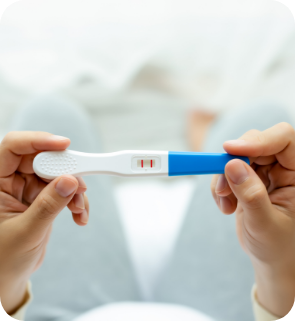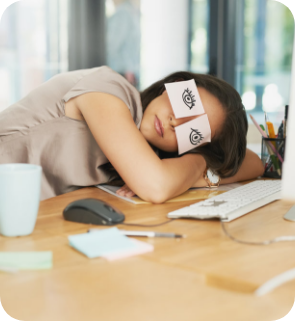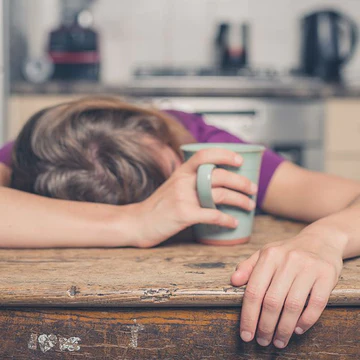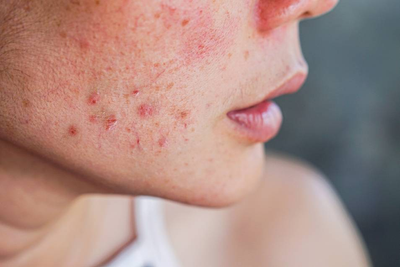
Reversing PCOS Hair Growth
One of the most unwanted and uncomfortable symptoms of PCOS is hirsutism, or excess hair growth.
Hirsutism is the excessive growth of facial or body hair on women seen as coarse, dark hair that will usually appear on the face, chest, abdomen, back, upper arms, or upper legs. Hirsutism is a symptom of excessive amounts of androgen hormones in the female system. PCOS is the most common cause of hirsutism.
Understanding Hair Growth
Understanding how normal hair grows will help you better understand hirsutism. Each of your hairs grow from a follicle deep in your skin. Hair follicles cover just about all areas of your body except the soles of your feet and the palms of your hands. You have approximately 50 million hair follicles covering your body, and 20% of them are located on the scalp of your head.
Adults have two types of hair, vellus and terminal. Vellus hair is the soft, fine, generally colorless, and usually short form of hair. On the other side, terminal hair is long, coarse, dark, and sometimes curly. In most women, vellus hair covers the face, chest, and back and gives the impression of “hairless” skin.
Excessive amounts of androgen hormones in the female system has the power the turn vellus hairs into terminal hairs. This is the root driver of hirsutism in women with PCOS.
Your hair grows in a cycle with the actual hair growing about 0.3mm to 0.4mm each day, which adds up to around six inches per year. However, not all of the hair follicles are growing new hair at the same time. Hair growth occurs in a cycle. At any given time, each strand is in a different part of the cycle. It’s a good thing that each of our hair’s cycles are not in sync, otherwise we would shed all of our hair at once!
This means throughout the year your hair is in a constant cycle of growing and replacing hair. It’s why when you brush your hair some will fall out and get stuck on your brush but, because you are always growing more you don’t notice hair loss on your head.
How Excess Androgens Affect Hair Growth
As I mentioned before, excess facial and body hair is usually the result of excess androgens in your system primarily produced by your ovaries and adrenal gland. The most common causes of hirsutism are:
- Excessive production of androgens by the ovaries
- Excessive sensitivity of hair follicles to androgens
- Excessive production of androgens by the adrenal glands
- Insulin resistance
- Menopause
- Certain medications
There are a few parts of your body that are especially sensitive to androgen hormones, these body parts are generally the upper lip, breasts, chin/jaw, lower stomach, inner thighs, and lower back. Your chest, upper stomach, and upper back are less hormone sensitive.
This is why, generally, hirsutism will affects these areas in women with PCOS.
High androgen levels in your system can cause some vellus (soft, fine, generally colorless) hairs in these areas to actually change and become terminal (long, coarse, dark) hairs. Unfortunately, excess androgen levels can have the opposite effect on the scalp, leading to female pattern baldness.
Excess androgens negatively impact your hair growth cycle as it shortens the ‘anagen’ growing phase. It also lengthens the time between the shedding of a hair and the start of a new anagen phase.
This means it takes longer for hair to start growing back after it is shed in the course of the normal growth cycle. The hair follicle itself also changes, shrinking and producing a shorter, thinner hair shaft, a process called "follicular miniaturization." As a result, thicker, pigmented, longer-lived terminal hairs are replaced by shorter, thinner, non-pigmented vellus hairs.
Treatment Options
There are many medications that your specialists may prescribe you to control your hirsutum, which generally fall under three categories:
Androgen Suppressing Medications
These medications aim to regulate the amount of active androgens in your system. Common medications in this category include metformin, birth control.
Androgen Receptor Blockers
These medications will actually attach itself to the part of the cells where the androgens will try to attach to, essentially blocking them from being able to affect the cell. Common medications in this category include spironolactone (Aldactone), flutamide (Eulexin), and Cyproterone (Diane, Diane-35, Dianette).
5 Alpha-Reductase Inhibitors
This group of medication helps to inhibit the enzyme responsible for allowing androgens to be able to convert into their active, and more potent form. Less of this enzyme means less active, potent androgens resulting in less androgenic side effects such as hair growth. Common medications in this category include eflornithine hydrochloride (Vaniqa) and Finasteride (Propecia or Proscar).
One downside of these medications is that it can take quite a while for you to see significant results, often taking up to 6 months and once you stop taking them, you’re left in the same position as before starting the medication.
There are other options for you to manage your hirustim on an ongoing basis, including:
Shaving
Shaving is the easiest and fastest way to remove unwanted hair. Shaving will cut the hair at the surface level of the skin, and consistent shaving should not make the hair grow back thicker, darker, or faster, unlike what we’re often told. The downside to shaving is obviously that it needs to be done frequently, can sometimes leave hairs that are still visible, and may cause painful ingrown hairs.
Waxing
Waxing is another technique you can use to remove unwanted hair and generally helps to keep hair away for a few weeks at a time. There are many home waxing kits you can buy or you can also, obviously get it down by your local beauty therapist.
Bleaching and Depilatory Creams
Bleaching creams help to remove the pigment (colour) from the hair, making it less visible, while depilatory creams dissolve the hair using chemicals like calcium thioglycolate or potassium thioglycolate.
Laser Hair Removal
Laser hair removal is done by a dermatologist who will apply an intense beam of laser light to an area of your skin to remove unwanted hair. This treatment is not permanent but can remove hair safely and for longer periods of time than waxing, shaving or creams. Laser hair removal can be quite costly and is not 100% successful in all women.
Electrolysis
Electrolysis is when a small needle is inserted into the hair follicle to deliver an electrical charge, essentially killing the hair down to its root. While electrolysis is considered a safe and effective form of permanent hair removal, some hairs may require several treatments.
All the treatments I’ve just listed will help you manage unwanted hair growth ongoing but, I wouldn’t be Drew Baird if I didn't say that to truly take control of your hirsutism you need to attack it at its core.
Natural Options To Reduce The Root Cause
Hirsutism is triggered by the underlying hormonal imbalance, androgen excess. If you truly want to control any unwanted hair growth you need to be focusing on reducing your androgen production. As mentioned earlier, androgen are primarily produced;
1) By your ovaries as a result of excess insulin, usually driven by insulin resistance
2) By your adrenals gland as a result of excess amounts of cortisol (stress)
Therefore, your plan to reduce your androgen production will be to focus on reducing insulin levels and stress levels. Here’s an overview on how to do that
To reduce insulin levels:
- Follow a low to moderate carbohydrate diet and ensure that the majority of the carbohydrates you are eating are low GI.
- Ensure you’re exercising 3-5 days per week with a combination of resistance and HIIT workouts
- Prioritize sleep! Aim for a minimum of 7 hours per night
- Get enough soluble fiber
- Supplement with inositol, NAC, cinnamon, and apple cider.
To reduce stress levels:
Make sure you’re not starving yourself to try and lose weight. Instead of thinking ‘low calorie’ think ‘high nutrient’
- Perform at least 2 restorative workouts per week. So, things like a nice 30 minute walk outdoors
- Limit caffeine to 200mg daily
- Try daily relaxation methods such as yoga, meditation, stretching, or simply taking a hot bath.
- Supplement with lemon balm, omega-3, ashwagandha, and green tea.
By tackling excess androgen production naturally you can correct the underlying hormonal imbalances that are at the core of your problem. You can absolutely combine this with medication or other treatments if you wish.
I know that excess hair growth and/or hair loss is an extremely emotionally hard aspect of PCOS. I had a lady message me just yesterday pouring her heart out to me explaining how having to shave more often than her husband and it makes her feel not like a woman. I can’t begin to imagine what that must feel like.
This is why I want to give you all this information and explain the deeper science of the hormonal imbalances so you can actually start to truly take control of these symptoms instead of simply masking them or letting them control you.
I hope this post helps.

















Leave a comment